About
Special News
Logan's Page
Jacoby's Page
Our Travel Index
Tracks Ahead Related Trips
Contact
Ireland & Scotland Trip - September 8 - 27, 2014
Ireland and Scotland
  |
We visit Western and southern Ireland, as well as Scotland.
|
Monday/Tuesday, September 8/9
Monday morning, Phoenix experienced a 100 year flood event. Some places got up to 5 inches of rain in about the same number of hours. If we had been leaving on an early flight, we never would have gotten out of town, as all the freeways were closed due to flooding. Fortunately, we had a 6:30 PM flight. Our shuttle driver picked us up a tad early, and we headed down the 303 to the 10, and then to Sky Harbor.
As it was, our Southwest flight looked like it was going to very, very late due to mechanical issues, and we opted to pay for a ticket on USAir, which got us into Milwaukee right on time: just before Midnight. After a short night, we headed back to the airport, and grabbed an earlier flight to Chicago. Which was good, as our original flight appeared to be delayed by, you guessed it, mechanical problems. So we connected at O’Hare, and hopped the flight to Newark. We lucked out and had only two people in a three row. So it was as comfortable as coach can be.
We hooked up with our friends (Fran & Alan,
Naomi, Helene & Barb) and killed some time at Newark.
Hello Ben & Jerry's.
And then boarded the cattle car to Shannon.
I have never been impressed with United, and while we did have
extra legroom due to the economy plus upgrade, the flight was, well, bus
like. The entertainment
system kept skipping, and the audio had issues.
And for the first time ever, we had to pay for wine.
Really? I wonder if
Greyhound can be as unfriendly?
Wednesday, September 10
After very little sleep, we made it to Shannon only slightly late. Customs and immigration was the usual non-event, but at least we have another passport stamp. And Barb can claim the Emerald Isle on her list of countries.
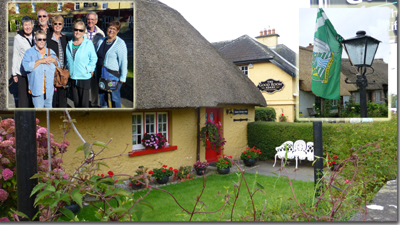 Our guide/driver, Con (short for Cornelius) met us with our minibus and
off we went. As it was quite
foggy, we opted not to drive to the Cliffs of Mor, and instead stopped
first in the tourist town of Adare.
Our guide/driver, Con (short for Cornelius) met us with our minibus and
off we went. As it was quite
foggy, we opted not to drive to the Cliffs of Mor, and instead stopped
first in the tourist town of Adare.
The thatched roof cottage were charming, and the colorful buildings added a touch of brightness to the morning.
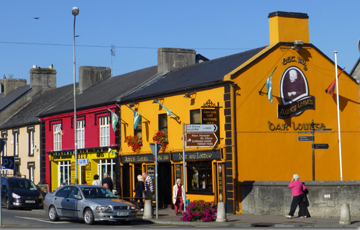
Right across the street from the church, in the small shops, we found a little breakfast place. What better than to start the day with a bit of additional mini Irish breakfast.
We all tried the black pudding, which is made with ingredients the only one of which I remember is congealed blood, and scones. All was quite good.

Back on the bus and out of County Limerick (no we did not do “There once was a man from Nantucket,”) and into County Kerry.

The big stop was in Killarney, where we will spend the night. The high point in town seemed to be St. Mary’s Cathedral, which is the second tallest in the country. Please note that the photo is NOT St. Mary's. This was just a random church in Killarney.
Our driver arranged for a hansom ride (called Jaunting carts) with a pal
named Kevin, who is probably a cousin.
The hansom was more like a small wagon with padded seats for the
seven of us,
 but the ride was lovely, through a 25,000 acre nature
preserve. This was around
Lower Lake, the largest of the three lakes to be found here.
It is deep, and cold, so think fishing and boating, but no
swimming.
but the ride was lovely, through a 25,000 acre nature
preserve. This was around
Lower Lake, the largest of the three lakes to be found here.
It is deep, and cold, so think fishing and boating, but no
swimming.
The main house is Muckross House, a Victorian mansion, and is under restoration. So our view was distant. The terminus of the ride was Ross Castle, a ruin, of which I think we will see more tomorrow. Like most of the ruins, it was done in by Cromwell’s forces. Mr. Cromwell is not well liked in these parts.
 In the background is the highest point in Ireland, Mt.
Carrauntoohil,
which tops out at 3500 feet give or take a few.
The skies are blue, and the temperatures in the mid 60’s so
things are pretty nice at the moment.
In the background is the highest point in Ireland, Mt.
Carrauntoohil,
which tops out at 3500 feet give or take a few.
The skies are blue, and the temperatures in the mid 60’s so
things are pretty nice at the moment.
We are at the Malton Hotel, where we crashed for a bit.
Now it is time to meet the golfers (Jim, Dan & Paul), who are
going to be all perky, as they have adapted to the local time, having
been here for a week. And
let’s get into some Guinness.
Drinks in the bar, and then on to McSweeneys for dinner.
We got Barb C to try Guinness.
I don’t think she was impressed. We
are all dead tired and heading for bed.
Thursday, September 11
We were all pretty tired last night. Even the golf guys were tuckered out. The hotel breakfast was great, with a choice of hot or cold selections. So after a good nights sleep, we headed out at the totally reasonable hour of 10 AM.

Our first stop was back to the national park, and first, a walk to the Torc waterfall. It was quite a serene jaunt into the woods, with the moss covered trees. The waterfall actually had water, and the bubbling stream looked quite refreshing.
 Then it was
on for a tour of Muckross House, which was the main residence for the
original owners of this estate.
A California woman married into the family around the turn of the
20th century, and added some touches to the place.
The furnishings were all period, and with 26 bedrooms, there was
plenty of living space. Of
note was a three bedroom suite which was prepared for a visit by Queen
Victoria. The preparations
took six years, and pretty much bankrupted the family.
The whole operation was handed over the Irish government around
19?? And the estate became the first national park.
Some of the hand carved furniture was pretty amazing.
Then it was
on for a tour of Muckross House, which was the main residence for the
original owners of this estate.
A California woman married into the family around the turn of the
20th century, and added some touches to the place.
The furnishings were all period, and with 26 bedrooms, there was
plenty of living space. Of
note was a three bedroom suite which was prepared for a visit by Queen
Victoria. The preparations
took six years, and pretty much bankrupted the family.
The whole operation was handed over the Irish government around
19?? And the estate became the first national park.
Some of the hand carved furniture was pretty amazing.
 Then it was
back in the bus for a drive to the Dunloe Gap, which was a valley
between the local mountains.
We ate lunch there at Kate Kearney’s Cottage, which sounded an awful lot
like Ruth's Diner outside of Park City, Utah. Kate was pretty
independent for her time, and was known for her poitin, pronounced “poo
chin!” Of course, there was still some for sale.
Con, our guide/driver said that you could still get the stuff
from various places through the area.
You just had to know the local moonshiners.
Then it was
back in the bus for a drive to the Dunloe Gap, which was a valley
between the local mountains.
We ate lunch there at Kate Kearney’s Cottage, which sounded an awful lot
like Ruth's Diner outside of Park City, Utah. Kate was pretty
independent for her time, and was known for her poitin, pronounced “poo
chin!” Of course, there was still some for sale.
Con, our guide/driver said that you could still get the stuff
from various places through the area.
You just had to know the local moonshiners.
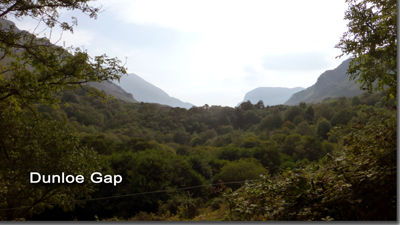
We took a brief walk up a hiking trail up towards the Gap, but decided after about a half a mile to bag the walk and head back to the bus.

A look at the Lower Lake, through the mist and haze, and some additional tower and cathedral ruins were next on the agenda.

Then it was back into town for a look at Mt. Mary’s Cathedral. Construction started in 1842, and the place was consecrated in 1855, although construction was not completed until 1917. Ireland is largely Catholic, and we all found it interesting that up until the 1960s; if a woman got married, she had to quit her job.
We walked
through the main street for a bit, and then had dinner at Laurel's Pub.
Honestly, I’ve had more beer in the last 48 hours than I’ve had
in the last six months back home.
The alcohol content must be less, because I certainly don’t feel
it. We are all still tired,
and after a short stay in another pub for a beer and some Irish music,
headed back to the room and bed.
Friday, September 12
The tour continued today, as we headed out for a ride around the Ring of Kerry. Southwestern Ireland has several rocky peninsulas that extent out into the Atlantic. The main northernmost is called the Dingle Peninsula, the southernmost the Beara and the middle one the Iveragh. The road around the latter is called The Ring of Kerry, and consists of a scenic drive on a very narrow track around the peninsula. One has to contend with large tour coaches, auto traffic and the usual trucks and people going about their normal business. The trip consists of about 140 km.
 Our first
stop was at the Kerry Bog Village, which was a nice little historic
display on the cutting and processing of peat, which is still used as a
major source of fuel for home heating, or just getting a nice ambient
fire going in your home.
Peat is decayed plant matter, which has compressed in a boggy
environment. Usually it is
cut by hand, yielding about a 4x4x16 inch strip with each cut.
This year, it has been dry enough that there have been three
cuttings. The composition is
about 95% water. The stuff
is laid out to let the sun so that the air can dry it, and the "logs"
are turned, stacked, and piled.
There are a lot of local names for the various steps in this
whole process, and I can’t remember a single one.
But it produces a nice little fire.
A stack roughly 4x6x4 would yield enough fuel for about 2-3
months, obviously depending on use.
Our first
stop was at the Kerry Bog Village, which was a nice little historic
display on the cutting and processing of peat, which is still used as a
major source of fuel for home heating, or just getting a nice ambient
fire going in your home.
Peat is decayed plant matter, which has compressed in a boggy
environment. Usually it is
cut by hand, yielding about a 4x4x16 inch strip with each cut.
This year, it has been dry enough that there have been three
cuttings. The composition is
about 95% water. The stuff
is laid out to let the sun so that the air can dry it, and the "logs"
are turned, stacked, and piled.
There are a lot of local names for the various steps in this
whole process, and I can’t remember a single one.
But it produces a nice little fire.
A stack roughly 4x6x4 would yield enough fuel for about 2-3
months, obviously depending on use.
 The museum
display had some reproduction homes from the 1800’s around the time of
the Great Famine (1842-48.)
The places were built of stone, with thatched roofs, and pretty humble.
Some had animal stables right inside the dwelling.
Some were large enough to have a loft for sleeping, although I
would bet that this was a cold area.
Most of the homes had the bed right next to the fireplace.
That area also doubled as the kitchen.
The museum
display had some reproduction homes from the 1800’s around the time of
the Great Famine (1842-48.)
The places were built of stone, with thatched roofs, and pretty humble.
Some had animal stables right inside the dwelling.
Some were large enough to have a loft for sleeping, although I
would bet that this was a cold area.
Most of the homes had the bed right next to the fireplace.
That area also doubled as the kitchen.
A word on the Great Famine. Ireland lost 20-25% of its population at that time, either through starvation, or emigration to America, Canada, or Australia. The whole thing started with English laws that reduced the poor Irish to subsistence farming on poor land. Enter the potato blight, which was a fungal disease carried in by the winds and reduced the main food staple to zero. Even today, they still spray to kill the fungus.
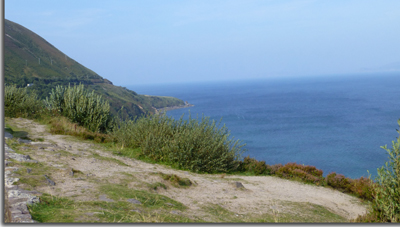
On to further viewing of the sights of the Atlantic were in order. While there was no rain, it was still pretty hazy, so visibility was marginal.
A :09 clip can be found here (wmv file).
 The Park
City folks had talked about the international sheep dog event held
annually in Utah. So it was with a great deal of interest that we
stopped at a sheep dog demonstration.
Different breeds of sheep were pointed out, and then the dogs –
border collies – were put to work showing how they could herd sheep,
making them go left, right, stop and start.
I’ve seen this before, but it still pretty impressive.
The Park
City folks had talked about the international sheep dog event held
annually in Utah. So it was with a great deal of interest that we
stopped at a sheep dog demonstration.
Different breeds of sheep were pointed out, and then the dogs –
border collies – were put to work showing how they could herd sheep,
making them go left, right, stop and start.
I’ve seen this before, but it still pretty impressive.

Another stop was to look at an ancient ring fort, which was built by a local chieftain. We stopped in Sneem for lunch, and then on to Kenmare for more shopping.

The final stop of the day was at A Lady’s View, which provided a nice vista of the Lakes of Kerry.
Then it was back to the hotel, and we discovered that my fear had
materialized: a wedding in the courtyard under our room.
Tonight may be a long one.
Saturday, September 13
We were practically first in line for breakfast this morning, along with a whole bunch of other tourists on the large motor coaches. I can’t believe how many tourists are here. Killarney must be THE top tourism spot.
We departed the Hotel Malton, which was an ex Great Southern Railway hotel. Oh. And the wedding? It broke up about 5 AM. Yikes.

We did got on the road right on time, and headed up the Caha Mountains as we moved from County Kerry to County Cork. The road was narrow and winding, and it was fortunate that we were headed in a southern direction, as we were met with almost 3,000 bicycles all doing a ride over the same mountains.
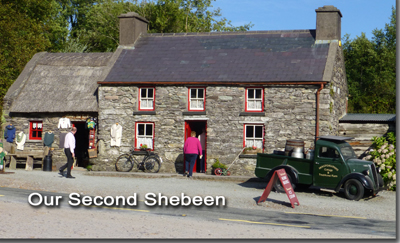 We stopped
for a bit at a coffee shop/gift shop which used to be another Shebeen, a
roadhouse specializing in white lightning.
A bathroom break was taken, gifts were purchased, and the local
economy helped. The land is
rocky, but hilly and green.
It is really quite lovely.
We stopped
for a bit at a coffee shop/gift shop which used to be another Shebeen, a
roadhouse specializing in white lightning.
A bathroom break was taken, gifts were purchased, and the local
economy helped. The land is
rocky, but hilly and green.
It is really quite lovely.
 The next
stop was a short boat ride out of Glengarriff to Garinish Island.
I think we were supposed to see the gardens on the island, but we
ended up just riding back to the harbor.
We got a look at harbor seals, some of whom looked as if they
were tired of being stared at.
The next
stop was a short boat ride out of Glengarriff to Garinish Island.
I think we were supposed to see the gardens on the island, but we
ended up just riding back to the harbor.
We got a look at harbor seals, some of whom looked as if they
were tired of being stared at.

Next stop was a small church at Ghuagan Barra (pronounced goo-gone Barra.) Con, our guide was married there. The small church was quite lovely, located on the shore of a lake, with rocky mountains all around. There was a wedding taking place, although we pretty much steered clear of it.
 We contented
ourselves with looking at the monks niches, from the ruined monastery
behind the church. The road
for all of this was rough, and I got bounced around in the back of the
bus. The bus is a bit
uncomfortable. The seats are
all very slippery, and we all keep sliding off the things.
And as I mentioned, the suspension as a little bouncy.
We contented
ourselves with looking at the monks niches, from the ruined monastery
behind the church. The road
for all of this was rough, and I got bounced around in the back of the
bus. The bus is a bit
uncomfortable. The seats are
all very slippery, and we all keep sliding off the things.
And as I mentioned, the suspension as a little bouncy.
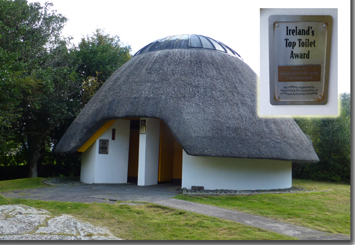 Of
note is the "Ireland Top Toilet Award." Really? Well, this
is one of them. We found restroom facilities across the country to
be many and all very clean. I must say, it beats the dickens out
of China. But then a country wouldn't have to do much to get
beyond that standard.
Of
note is the "Ireland Top Toilet Award." Really? Well, this
is one of them. We found restroom facilities across the country to
be many and all very clean. I must say, it beats the dickens out
of China. But then a country wouldn't have to do much to get
beyond that standard.
Lunch was at the Snug Bar (what else) in Bantry. From there we took a narrow, winding road to our destination, Kinsale. The roads are all narrow and winding, but this was exceptional. Although our driver said it was the least tortuous of all his options.
 Kinsale is a
definite tourist town. There
are plenty of shops and pubs.
We had some recommendations, but opted instead to ask locally
where people would go. And who better to ask than a couple of
local butchers. Paul, in his inimitable style, made new friends
and elicited good reviews of where they would go.
And we ended up in very fun place called Jim Edwards.
We had a lot of laughs and good food.
Our waitress’s name was E! fa, spelling Aoife.
We walked a bit, and headed back to the Trident Hotel.
Kinsale is a
definite tourist town. There
are plenty of shops and pubs.
We had some recommendations, but opted instead to ask locally
where people would go. And who better to ask than a couple of
local butchers. Paul, in his inimitable style, made new friends
and elicited good reviews of where they would go.
And we ended up in very fun place called Jim Edwards.
We had a lot of laughs and good food.
Our waitress’s name was E! fa, spelling Aoife.
We walked a bit, and headed back to the Trident Hotel.
Sunday, September 14
We sort of tossed and turned all night, as it was a tad damp due to the sea air. Breakfast was good, and off we went to probably the number one tourist attraction in Ireland: Blarney Castle.
 Legend has
it that whomsoever shall kiss the Blarney Stone will be given the gift
of eloquence, or gab. It is
not likely that this group need any help with the latter.
I was a little afraid that performing the kiss might rob Paul of
his gabby gift, as I can’t imagine how one could add to it.
Only ime will tell.
So far, we are seeing no results one way or the other.
Legend has
it that whomsoever shall kiss the Blarney Stone will be given the gift
of eloquence, or gab. It is
not likely that this group need any help with the latter.
I was a little afraid that performing the kiss might rob Paul of
his gabby gift, as I can’t imagine how one could add to it.
Only ime will tell.
So far, we are seeing no results one way or the other.
The castle itself has been restored enough to suck out those tourist dollars, and the climb up to the top was via very tight and narrow winding stone staircases. To pass the time, we made best friends with the couple in front of us, who were from Victoria, Australia. I have yet to meet an unfriendly Aussie.
To “Kiss the Blarney Stone,” one must lay on their back, bend backwards over a steep and lengthy drop, and kiss the stone in the wall. Sounds complicated. But there is a helper stationed there who has you in and done in about 30 seconds. Really, it was fast.
And of course, your photo is taken, suitable for immediate purchase in the gift shop. To which we succumbed.
 Barb headed
for the exit and the inevitable gift shop, and I took a brief walk
through the Poison Garden, which had a sample of lots of things you
didn’t want to eat, smell, or touch.
I have read about these things, which seemed to enjoy some popularity un
the UK and around the world to a lesser extent. The concept of
having a garden filled with things that can kill you is a tad strange to
my way of thinking. But each to his own.
Barb headed
for the exit and the inevitable gift shop, and I took a brief walk
through the Poison Garden, which had a sample of lots of things you
didn’t want to eat, smell, or touch.
I have read about these things, which seemed to enjoy some popularity un
the UK and around the world to a lesser extent. The concept of
having a garden filled with things that can kill you is a tad strange to
my way of thinking. But each to his own.
Barb got a little turned around and we met on the way out. Through the gift shop. Fortunately we beat most of the big tour buses, so we were in and out in about 45 minutes.
 The next
stop was the Jameson Distillery, where we had the customary lunch, and
better, a sample tasting. We
had three samples: Jameson’s
12 year old Irish whisky, Johnny Walker Black, and Jack Daniels.
The Jack was really pretty nasty.
No wonder I don’t like the stuff.
The Black Label was smooth, and peaty, as would be expected for
scotch. And the Jameson’s
was smooth, and really rather tasty.
It turns out these guys also make Paddy and Redbreast, so we will
have to hit Total Wine when we get back.
The prices here were outrageous.
Dan said that due to excise taxes, Irish whisky is cheaper in the
States than here.
The next
stop was the Jameson Distillery, where we had the customary lunch, and
better, a sample tasting. We
had three samples: Jameson’s
12 year old Irish whisky, Johnny Walker Black, and Jack Daniels.
The Jack was really pretty nasty.
No wonder I don’t like the stuff.
The Black Label was smooth, and peaty, as would be expected for
scotch. And the Jameson’s
was smooth, and really rather tasty.
It turns out these guys also make Paddy and Redbreast, so we will
have to hit Total Wine when we get back.
The prices here were outrageous.
Dan said that due to excise taxes, Irish whisky is cheaper in the
States than here.
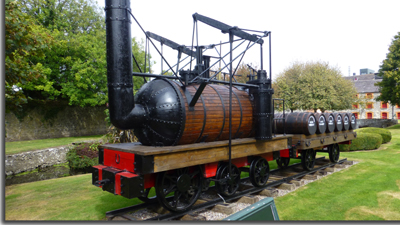
There was a nice little horizontal boiler locomotive, with a walking beam old steam engine on display.
 We drove
past and around Cork, and rather than spend any time there, we went on
to Clonakilty, which is south of Kinsale, and a bit out of the way.
The attraction was the West Cork Model Railway Village.
Started as a community project about 20 years ago to give
tradespeople some training in concrete, carpentry, and the like, the G
gauge railway models the West Cork Railway.
Towns are set up, with historical accuracy, and the major points
of the lines are on display.
There is a visual history of the place and some old equipment on
display. Con, our driver, said that
in all his years of guiding/driving, no one had EVER asked to go to this
place. Well, he now has a new suggestion for people!
We drove
past and around Cork, and rather than spend any time there, we went on
to Clonakilty, which is south of Kinsale, and a bit out of the way.
The attraction was the West Cork Model Railway Village.
Started as a community project about 20 years ago to give
tradespeople some training in concrete, carpentry, and the like, the G
gauge railway models the West Cork Railway.
Towns are set up, with historical accuracy, and the major points
of the lines are on display.
There is a visual history of the place and some old equipment on
display. Con, our driver, said that
in all his years of guiding/driving, no one had EVER asked to go to this
place. Well, he now has a new suggestion for people!

Then it was a brief stop at the Grotto in Ballinspittle, a hillside shrine. While not unusual in this very Catholic country, this one claims significance, which commenced in 1985, when two local families observed the statue to be moving. Movement was also claimed to be seen in subsequence viewings by additional local people. At this point, up to a million people have passed by, claiming appraritions, cures and unusual experiences.

Then on to the Charles Fort in Kinsale, for a brief look at an old star fort.
Back to the
hotel.

So off we go from Kinsale. Our first stop was the little town of Cashel, to look at a castle. The import of this place was supposedly where St. Patrick banished Satan.
Rather than walk up to the castle, Paul, Dan and I walked to a little folk village museum. We learned more about the history of Ireland in 20 minutes than I had in the last 60 years.
In brief,
the Penal Laws set up the oppression of the Catholics. The Irish
ended up only being able to have the poorest of land, which was suitable
for one crop - potato's. Enter the potato blight, a fungus which
originated in (of all places) Mexico.
 Blown in on the winds from
continental Europe, this disease was enough to set in place the perfect
storm to decimate the population.
At the time of a famine, the British in Ireland were exporting grain and
meat. To help alleviate the situation, the British finally set up
the workhouse situation, which was draconian, and much to slight an
effort to alleviate general suffering. Families were split up,
with work and living conditions abysmal. So the restrictive laws,
the crop failure, and terrible conditions all around made for a
national disaster. The
museum was slanted toward all this "the British did all this to us"
approach, and as a result, was not on the "approved" tourist
destinations. But it was a find, and interesting to see another,
darker side of Irish history.
Blown in on the winds from
continental Europe, this disease was enough to set in place the perfect
storm to decimate the population.
At the time of a famine, the British in Ireland were exporting grain and
meat. To help alleviate the situation, the British finally set up
the workhouse situation, which was draconian, and much to slight an
effort to alleviate general suffering. Families were split up,
with work and living conditions abysmal. So the restrictive laws,
the crop failure, and terrible conditions all around made for a
national disaster. The
museum was slanted toward all this "the British did all this to us"
approach, and as a result, was not on the "approved" tourist
destinations. But it was a find, and interesting to see another,
darker side of Irish history.
The museum contents included a gypsy caravan, and the history of the 1916 revolution, as well as a lot of artifacts. Admittedly, the whole presentation was a little one sided, looking at it from the side of the revolution, but still, with a garrulous proprietor, it made for an informative morning.
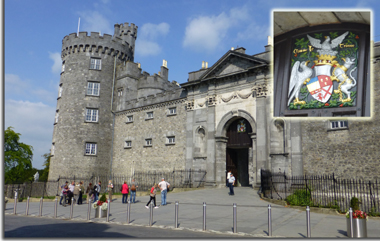
Next stop was Kilkenny, the Kilkenney Castle. Occupied by the Butler Family until roughly 1935, the place is now a state institution and has been restored. At the height of their day, the Butlers owned one in four farms in Ireland. And the received revenue from the British for wine.

We walked through the town,, finally spotting an actual limerick. This one reads: "There were two cats from Kilkenny, Who thought that was one cat to many. So they found and they fit, and they scratched and they bit. And instead of two cats there aren't any." (Rim shot)
 The
town walk ended up at the Cathedral of St. Canice.
This cathedral had a huge tower, which was available to climb.
Barb C opted to make the climb and headed for the top of the
tower for an amazing view of the countryside.
The
town walk ended up at the Cathedral of St. Canice.
This cathedral had a huge tower, which was available to climb.
Barb C opted to make the climb and headed for the top of the
tower for an amazing view of the countryside.
Paul and I opted to view from the ground, as that height and small standing area makes butterflies appear in my stomach.
As we were pressed for time was had a take away lunch at a local café. And we received talkative directions from a guy on the street. Apparently, no Irishman can say, “go straight, turn left” in four words.
We finally made it back on the bus and into Dublin. There was a lot of traffic, as would be expected in a large city of a million or so. We had a great dinner on Petroshore at the hotel. There was an issue with the AC, but hotel maintenance got it working. This was a good thing, because we were on the second floor, on the street, and the noise was pretty bad.
Tuesday, September 16
 Today, Paul
and Naomi, Barb and I deviated from the plan.
We skipped the outlying garden tour, and instead opted to start
with the hop-on hop-off bus tour.
We rode the whole line, which took about an hour, and got a
general feel for places in the city we would like to revisit.
Originally, we were going to stop at the jail, but opted instead
to hold that until tomorrow.
Con said that would be the first thing on the tour for Wednesday, so we
shall do that. And probably
the Guinness tour will happen about that time as well.
I guess taking a trip means nothing like starting drinking in the
morning.
Today, Paul
and Naomi, Barb and I deviated from the plan.
We skipped the outlying garden tour, and instead opted to start
with the hop-on hop-off bus tour.
We rode the whole line, which took about an hour, and got a
general feel for places in the city we would like to revisit.
Originally, we were going to stop at the jail, but opted instead
to hold that until tomorrow.
Con said that would be the first thing on the tour for Wednesday, so we
shall do that. And probably
the Guinness tour will happen about that time as well.
I guess taking a trip means nothing like starting drinking in the
morning.
 So our first
stop was at a history museum in the City Hall.
It was quite informative, and we learned a great deal about the
rise of Dublin (means Black Pool) at the confluence of two rivers.
The main one, the Liffy, stills splits the town.
The Vikings started it all rolling, followed by the Normans, then
the English, although I think the Pics were in there someplace.
There was plenty of printed material, but the best was the old
film footage that took you from the early 1900’s through the 1980’s.
So our first
stop was at a history museum in the City Hall.
It was quite informative, and we learned a great deal about the
rise of Dublin (means Black Pool) at the confluence of two rivers.
The main one, the Liffy, stills splits the town.
The Vikings started it all rolling, followed by the Normans, then
the English, although I think the Pics were in there someplace.
There was plenty of printed material, but the best was the old
film footage that took you from the early 1900’s through the 1980’s.
Then it was a brief lunch in the Temple Bar, and to Dublin Castle.
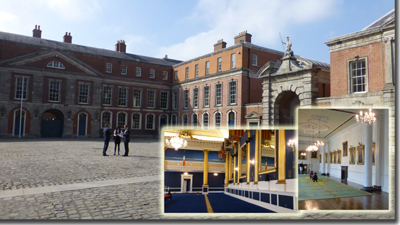 The castle
tour featured a display of the staterooms, and a further tour included
some of the old architectural bases of the walls and castle grounds.
The tour included seeing some of the old walls and structure
foundations that dated back to the Viking times.
The castle
tour featured a display of the staterooms, and a further tour included
some of the old architectural bases of the walls and castle grounds.
The tour included seeing some of the old walls and structure
foundations that dated back to the Viking times.
Barb was on a mission to find additional gifts, so that was accomplished on Grafton Street. However, for me, it was fun watching the loads of people passing by. We are all now resting.
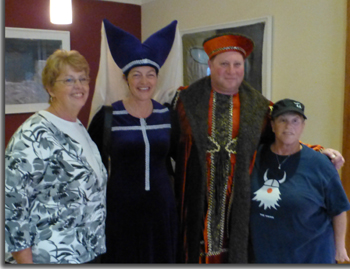 We think we
made a wise choice today. It
would have been impossible to do what we did, plus the jail and the
Guinness tour in one day. Arriving
back at the hotel, we ran into a group dressed in medieval costumes.
In the spirit of the moment, we had some photos taken, making the
assumption that these folks wer part of some local pagent or "theme"
event. Ha! It turns out that they were a group from South
Africa who come to play "dress up" once a year. Who woulda'
thought.
We think we
made a wise choice today. It
would have been impossible to do what we did, plus the jail and the
Guinness tour in one day. Arriving
back at the hotel, we ran into a group dressed in medieval costumes.
In the spirit of the moment, we had some photos taken, making the
assumption that these folks wer part of some local pagent or "theme"
event. Ha! It turns out that they were a group from South
Africa who come to play "dress up" once a year. Who woulda'
thought.
The front
desk sent us out for dinner to two pubs which were in the opposite
direction from the Temple Bar area.
Well, first Paul and I turned out to be terrible map readers, and
we almost immediately got lost.
Our destinations were a considerable distance from the hotel.
And when we finally did arrive at the two pubs, they were both
marginal at best. We ceded
the field to the women, and ended up at the place called the Hairy
Lemon. It was a lot of fun,
with good food. And it
turned but to be right at the end of the block for the hotel.
Who knew?
Wednesday, September 17
 As planned,
our first stop was the Kilmainham Gaol Museum.
This was a tour of the first Irish “progressive” prison.
The place was constructed outside the city walls back in 1798,
and was used until roughly 1924.
The leaders and participants of all the Irish rebellions were
housed and/or executed here.
It was the rather brutal executions of the 1916 rebellion, however, that
turned public opinion against the British, and toward the independence
movement. The jail was a
rather bleak place, as would be expected.
Both men, women and children were housed in the place.
While it is a dismal structure by today's standards, it was
considered to be quite progressive for it’s time.
The stone cells were cold and dank, although I believe that the guide
said that there were very few prisoners that died of disease. Which
was a major accomplishment for the time.
As planned,
our first stop was the Kilmainham Gaol Museum.
This was a tour of the first Irish “progressive” prison.
The place was constructed outside the city walls back in 1798,
and was used until roughly 1924.
The leaders and participants of all the Irish rebellions were
housed and/or executed here.
It was the rather brutal executions of the 1916 rebellion, however, that
turned public opinion against the British, and toward the independence
movement. The jail was a
rather bleak place, as would be expected.
Both men, women and children were housed in the place.
While it is a dismal structure by today's standards, it was
considered to be quite progressive for it’s time.
The stone cells were cold and dank, although I believe that the guide
said that there were very few prisoners that died of disease. Which
was a major accomplishment for the time.
 When I was
here in 2005, we opted not to do the Guinness tour, as it was too
costly. I rectified that
mistake today. The tour was
absolutely THE best brewery tour I have ever taken.
And we never went near the brewery!
The multimedia presentations were well done, and walked you
through the whole process as you moved from station to station.
Of particular interest, was the advertising.
The print advertising and posters are primarily the work of John
Gilroy, who had a penchant for making odd animals look quite cute.
Hence you tend to see the use of the ostrich, the toucan, and the
seal. These animals became icons in the Guinness commercial work.
Gilroy was quite an accomplished portrait painter as well, and
did portraits of the Royal Family, Winston Churchill, and other
notables.
When I was
here in 2005, we opted not to do the Guinness tour, as it was too
costly. I rectified that
mistake today. The tour was
absolutely THE best brewery tour I have ever taken.
And we never went near the brewery!
The multimedia presentations were well done, and walked you
through the whole process as you moved from station to station.
Of particular interest, was the advertising.
The print advertising and posters are primarily the work of John
Gilroy, who had a penchant for making odd animals look quite cute.
Hence you tend to see the use of the ostrich, the toucan, and the
seal. These animals became icons in the Guinness commercial work.
Gilroy was quite an accomplished portrait painter as well, and
did portraits of the Royal Family, Winston Churchill, and other
notables.
The television advertising was also interesting, moving from the 1950s to today's regionally focus messages.
 The tour
culminated at the “Guinness Academy” where we all learned to pour the
perfect pint. The trick is
to pour down the side until almost full and then let it sit to let the
nitrogen and CO2 come to the top.
Then top off. And
serve it at 45 degrees. We
had lunch at the place and hit the gift shop - all exits are through the
gift shop. The place wasn’t
quite the madhouse that it was when we were here in ’05, but it was
close. Unfortunately, the
shirt I wanted was not available in my size.
Too bad.
The tour
culminated at the “Guinness Academy” where we all learned to pour the
perfect pint. The trick is
to pour down the side until almost full and then let it sit to let the
nitrogen and CO2 come to the top.
Then top off. And
serve it at 45 degrees. We
had lunch at the place and hit the gift shop - all exits are through the
gift shop. The place wasn’t
quite the madhouse that it was when we were here in ’05, but it was
close. Unfortunately, the
shirt I wanted was not available in my size.
Too bad.
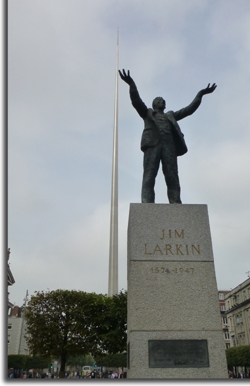
Then we headed down to O’Connell Street, for a shot of The Spire, a millennium memorial. Locally known by several names, my favorites were “The Rod to God” and “The Stiffy on the Liffey.” We walked a bit, took the hop-on hop-off bus around the dock area (mech) and came back to the hotel.

On the way back we passed by another Dublin Landmark, the statue of “Sweet Molly Malone.” The lass of Irish ballad fame, she is locally named the “Dish with the Fish” or the “Tart with the Cart.”

Dinner was in the Temple Bar area, at Oliver St. James Gogarty. Occupancy was a whopping 876. Our compatriots are in the dining room, but Barb and I opted for the bar, with both contemporary and Irish music as a background. These places are all jammed. I can see that tourism is a huge deal for the county.
It is time
to pack for our flight tomorrow.
Ireland has been a wonderful experience.
We were well treated, and the country is beautiful.
Thursday, September 18
It is election day in Scotland! The big issue of sessesion from the UK will be decided today. So after a sleepless night, we were up early and off to the airport. Dublin airport was rather large, although not on the scale of Dubai. But still, there were loads of travelers.
The hop to Edinburgh was short. Our driver was late due to fog and traffic. But we finally connected with George, our driver, got on the road. A big thrill for me was to see the Firth of Forth Bridge, even though it was seen through fog and mist. Wow. George said we would see it again in better weather. But still. Really neat for me. Unfortunately, the rain and fog and our speed made a photo impossible. So the reader will have to wait for better weather. Trust, me, it will be worth it.

Our drive continued for about an hour and half in the fog and mist to St. Andrews. Lunch was at a great fish and chips place in St. Andrews. The whole town is dedicated to golf.
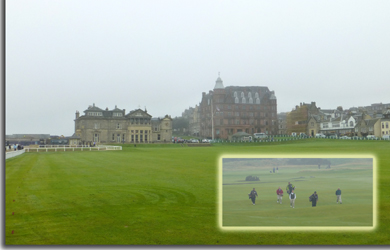
So of course, we had to take a trip to the Old Course, where we walked around a bit on the 1 & 18 fairways. Town was cute, but the prices were high. This is, after all, the Mecca for golfers.
 Paul suggested that
he and I
take the train back to Edinburgh. George dropped us at the
station, and we ran for the 4:25 train. This turned out to be the
East Coaster heading down from Aberdeen and points north.
The train was packed, and we barely were able to find seats. Like
most European trains, the ride was smooth, quiet and comfortable.
While the others rode the bus back to Edinburgh, Paul and I got to cross
the Firth bridge. Cool.
A little train video can be found
here.
Paul suggested that
he and I
take the train back to Edinburgh. George dropped us at the
station, and we ran for the 4:25 train. This turned out to be the
East Coaster heading down from Aberdeen and points north.
The train was packed, and we barely were able to find seats. Like
most European trains, the ride was smooth, quiet and comfortable.
While the others rode the bus back to Edinburgh, Paul and I got to cross
the Firth bridge. Cool.
A little train video can be found
here.
 Our
arrival back in Edinburgh was right next to this - the Balmoral Hotel.
It is her that J. K. Rowling penned many
of the "Harry Potter" books. It is said that her rooms (suite)
on the corner rent for several thousand Euros per night. I guess those rentals
would be by people seeking inspiration? Later Barb and I stopped
in for a drink, and had a look around. It is "Old World" opulent.
Our
arrival back in Edinburgh was right next to this - the Balmoral Hotel.
It is her that J. K. Rowling penned many
of the "Harry Potter" books. It is said that her rooms (suite)
on the corner rent for several thousand Euros per night. I guess those rentals
would be by people seeking inspiration? Later Barb and I stopped
in for a drink, and had a look around. It is "Old World" opulent.
We had a slow dinner
in hotel. We are all tired.
Friday, September 19
The UK will stay intact, at least for the moment. The vote came down on the side of Scotland staying with Britain, instead of going it alone. It was rather fun to be here for this event.
We met our walking guide this morning at 9 AM. Jane Sanderson was a Scottish lady, about our age, and very well informed, well spoken, and great fun to be with. She was also a touch opinionated, as she said, “most of us older Scottish women tend to be.” Which made her doubly interesting.
She was the coach for the National Women’s Curling team, which played in the Nagano, Japan Olympics. She did say that good golfers tend to make good curlers, as reading the green, is like reading the ice.

The plan was to walk through the Old Town potion of Edinburgh, down the Royal Mile to Holyrood House and on to the parliament building. From here we were to hike up to Edinburgh Castle. Signs for strange foods were everywhere. Some are self-explanatory, others not so much.
 Starting at
the beginning, we have the Sir Walter Scott Monument, locally referred
to as the "Gothic Rocket."
It is the world’s largest monument to a writer.
If you climb the 287 steps to the top, you are supposed to get a
wonderful view of the city.
As we could barely see to the next block due to the fog and mist, we
opted to skip that event.
Located right next to the train station, it certainly typifies
the Victorian Gothic look of much of the city.
I had to settle for a view of the usual "guy on a horse," a monument to
the first Duke of Wellington, Arthur Wellesley.
Starting at
the beginning, we have the Sir Walter Scott Monument, locally referred
to as the "Gothic Rocket."
It is the world’s largest monument to a writer.
If you climb the 287 steps to the top, you are supposed to get a
wonderful view of the city.
As we could barely see to the next block due to the fog and mist, we
opted to skip that event.
Located right next to the train station, it certainly typifies
the Victorian Gothic look of much of the city.
I had to settle for a view of the usual "guy on a horse," a monument to
the first Duke of Wellington, Arthur Wellesley.

The old town was the original portion of the town, anchored at one end by the castle, and the other by Holyrood. The term “rood” means cross, and the term “haar” means misty fog. There was a lot of “haar” today. But I always sort of think of Scotland as misty and foggy. I was not disappointed.
Interesting to me was the white cross on the Scottish flag. It is because St. Andrew was crucified on a X cross, rather than the typical upright type.
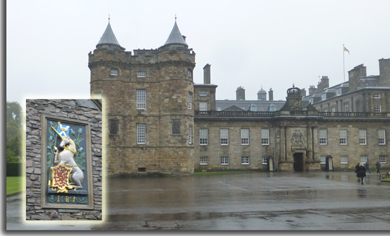 Holyrood
House was the stop on the way from London to Balmoral Castle for the
Royal Family. The Queen
still shows up once a year to hang out, throw a garden party, and
generally show support for Scotland.
After today’s election, I suspect she may come a bit more often
for a while.
Holyrood
House was the stop on the way from London to Balmoral Castle for the
Royal Family. The Queen
still shows up once a year to hang out, throw a garden party, and
generally show support for Scotland.
After today’s election, I suspect she may come a bit more often
for a while.
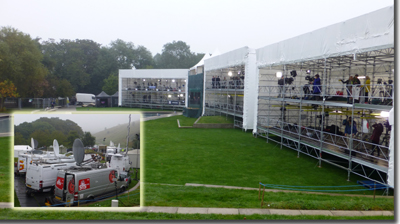
Due to the election, practically every uplink truck and camera crew from all over the world was here. I talked to two crews, both shooting B roll; one from Finnish TV, the other from Belgian TV. I sort of miss that sort of thing. But then again, not really.
 The Scottish
Parliament House was a modern building that carried forth the design of
a skating figure. Most of us
had to strain to see this resemblance.
The jutting projections are supposed to be “thinking pods” for
the members to use to ponder good things for the country.
Pardon my skeptism. Frankly,
while it may be a wonderful, modern design, it really doesn't fit in
with the rest of the city architecture.
The Scottish
Parliament House was a modern building that carried forth the design of
a skating figure. Most of us
had to strain to see this resemblance.
The jutting projections are supposed to be “thinking pods” for
the members to use to ponder good things for the country.
Pardon my skeptism. Frankly,
while it may be a wonderful, modern design, it really doesn't fit in
with the rest of the city architecture.
 Next, we
hiked up the Royal Mile, the medieval thoroughfare that was the main
road. There are a lot of
little side alleys, called “closes” that split off.
They were called “closes” because in the old days, night time
crime was rampant, and you could gate these alleys, or “close” them off.
We will further explore one of these tomorrow. The "World's End"
pub was the bar that was closest to the old wall of the city. It
really as "the end of the world" for the town inhabitants.
Next, we
hiked up the Royal Mile, the medieval thoroughfare that was the main
road. There are a lot of
little side alleys, called “closes” that split off.
They were called “closes” because in the old days, night time
crime was rampant, and you could gate these alleys, or “close” them off.
We will further explore one of these tomorrow. The "World's End"
pub was the bar that was closest to the old wall of the city. It
really as "the end of the world" for the town inhabitants.
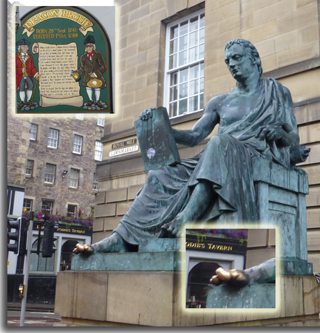 If
you note the "golden" toe of the pictured bronze statue of Scottish
philosopher/historian David Hume, you are supposed to recieve good luck.
Interesting that he is right across the street from the bar that was
home to Jame Brodie, the statesman cum thief who inspired Robert Louis
Stevenson's story "Dr. Jekyll & Mr. Hyde."
If
you note the "golden" toe of the pictured bronze statue of Scottish
philosopher/historian David Hume, you are supposed to recieve good luck.
Interesting that he is right across the street from the bar that was
home to Jame Brodie, the statesman cum thief who inspired Robert Louis
Stevenson's story "Dr. Jekyll & Mr. Hyde."
The walking tour ended (thank you, as I was trashed, and everyone was pretty tired) at Edinburgh Castle. Guide Lady Jane had to be very careful where she stood on the grounds, as her type of guide was in direct conflict with the “official castle” guides. We found it quite amusing.

The castle
had some nicely restored areas, such as the Great Hall and the Royal
residences. There was a
Prisoner’s Museum, as the place was used for captured POWs even up
through WW2. We heard the
One O'clock Gun go off, which is a tradition, and occurs practically
every day of the year. It is
said that when it fires, the tourists jump and the locals check their
watches. We had lunch in a
museum café, with Paul again getting haggis.
And of course, we all tried it.
Having had it for breakfast, I was not surprised, and both Barb
and I found it rather tasty.
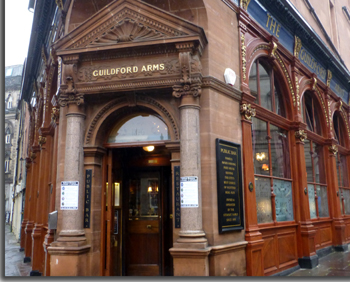
Then it was time for the Edinburgh version of the hop-on hop-off bus. I confess that I dozed though a bunch of this, as it was still rather “haary” and warm. It turned out that the bus stopped right across the street from the hotel.
So we are warm and dry, and planning dinner at a little pub right
around the corner, the Guildford Arms. The other
direction is a more upscale establishment.
It will have the wait.
Saturday, September 20
Today started off with rain. Gosh, but what a surprise. I expected to see MacBeth. It was that kind of weather.
 Our concierge suggested that we head for Mary Kings Close first.
We caught the first bus at 9:30, and headed straight there.
And we found that the first available tour was 11:45.
It was a good thing we didn't delay!. The tour booked, the ladies did some shopping, and Paul and
I headed
out on a mission. Due to his Scottish heritage, Paul has always
wanted a kilt. So we had some directions to a used kilt store.
Used kilts? Really? Really!
After some walking, we stumbled into a store that was owned and
operated by a fourth generation Scotsman from Punjab.
He had a deal on a whole package for a party kilt, with eight
pieces. I confess, I was tempted,
but did not succumb. So after making a
new friend, and some major joking around, we departed in time for the
tour of life in Medieval Edinburgh.
What would Scotland be without bagpipe music. Listen
here.
Our concierge suggested that we head for Mary Kings Close first.
We caught the first bus at 9:30, and headed straight there.
And we found that the first available tour was 11:45.
It was a good thing we didn't delay!. The tour booked, the ladies did some shopping, and Paul and
I headed
out on a mission. Due to his Scottish heritage, Paul has always
wanted a kilt. So we had some directions to a used kilt store.
Used kilts? Really? Really!
After some walking, we stumbled into a store that was owned and
operated by a fourth generation Scotsman from Punjab.
He had a deal on a whole package for a party kilt, with eight
pieces. I confess, I was tempted,
but did not succumb. So after making a
new friend, and some major joking around, we departed in time for the
tour of life in Medieval Edinburgh.
What would Scotland be without bagpipe music. Listen
here.
The "closes," as previously explained, were all narrow alleys, and this one Mary Kings, has been preserved. The alleys all descended down the hill, to the banks of the estuary, and the further down you lived, the lower your status. Life was pretty humble no matter where you lived. The quarters were cramped, possessions were few, and sometimes your livestock lived with you. The cry of "garde loo" meant that chamber pots were simply emptied out the door twice a day, to drain into the North Loch. And that is where the town also got it’s drinking water. So disease was always an issue. Add in pneumonic and bubonic plague, and you had just a wonderful place. The smell must have been enough to bowl you over. But once the city ousted everyone from these places, and deemed them unfit for habitation, there were still people living there. It was, after all, "home."
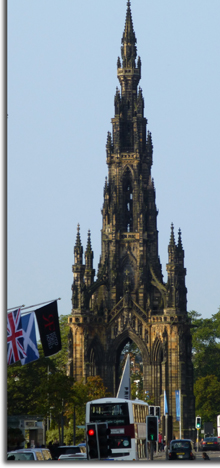 Higher up the food chain was a merchant house from the 17th
century. Gladstone's Land was
a preservation of the home of a prosperous merchant, complete with
furnishing. It had some
pretty neat painted ceilings and offered a look into life at that time.
Higher up the food chain was a merchant house from the 17th
century. Gladstone's Land was
a preservation of the home of a prosperous merchant, complete with
furnishing. It had some
pretty neat painted ceilings and offered a look into life at that time.
As the sky was blue and clear, I had the opportunity to finally catch a photo of the Sir Walter Scott Memorial, which as previously stated, is known locally as the "Gothic Rocket." It really does resemble one, doesn't it?
The closes, the Castle and the shops
between were all in Old Town.
Around the end of the 1700’s, and recognizing the abysmal living
conditions in the city, a plan was made for New Town, which was across
the North Loch. A plan was
laid out which had three main streets, with gardens at each end of the
development. Hence Princes,
George and Queen Street came to represent the place where the new and
affluent would live. It took
about 50 years for things to develop, but the place is now a wonderful
slice of Georgian History.
All the
 buildings in the area (save one) have been preserved.
buildings in the area (save one) have been preserved.
One house open to the public was the Georgian House. It offered a look into life of a prosperous landowner in the 1800’s. The furniture and contents were all period, and it offered a really nice look at life in those times. The tour included a short video presentation on what the family and their servants did on a typical day. The owner was living beyond his income, so eventually the place had to be sold off. The facility is now part of the Scottish Preservation Trust, and right next door to the office and residence of the Scottish Parliamentary Minister.
 The following bus ride yielded some shots of the
round Robert Burns
Memorial, the inverted telescope Lord Nelson Monument, and the building which was started
as the Scottish Parliament.
Incidentally Edinburgh was called the “Athens of the North” and has many
monuments and Grecian style columns on buildings.
The following bus ride yielded some shots of the
round Robert Burns
Memorial, the inverted telescope Lord Nelson Monument, and the building which was started
as the Scottish Parliament.
Incidentally Edinburgh was called the “Athens of the North” and has many
monuments and Grecian style columns on buildings.
Sunday,
September 21
Of course, it was a beautiful day as we departed Edinburgh.
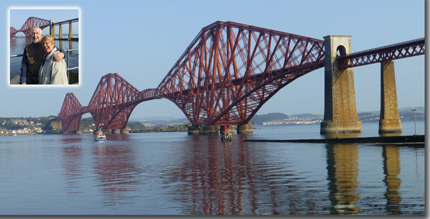 The first stop of the
day was the Firth of Forth Bridge as seen from
Queensferry. Built in 1890,
the whole thing was the first structure built of steel, and it was way
over engineered due to the Tay Bridge disaster of about ten years
earlier. So cool.
Did I mention that this was way
cool? It was considered to
be the 8th wonder of the world when it was built.
And it still holds a high place in engineering marvels.
You really can't grasp the scope of this thing, unless you can relate it
to a known object. We were fortunate to see a train go over it, so
you can see the scale of this magnificent structure. I am so
stocked about seeing this. So make fun of me if you will, but this
was a definite highlight. Video material is
here.
The first stop of the
day was the Firth of Forth Bridge as seen from
Queensferry. Built in 1890,
the whole thing was the first structure built of steel, and it was way
over engineered due to the Tay Bridge disaster of about ten years
earlier. So cool.
Did I mention that this was way
cool? It was considered to
be the 8th wonder of the world when it was built.
And it still holds a high place in engineering marvels.
You really can't grasp the scope of this thing, unless you can relate it
to a known object. We were fortunate to see a train go over it, so
you can see the scale of this magnificent structure. I am so
stocked about seeing this. So make fun of me if you will, but this
was a definite highlight. Video material is
here.
 George loaded us up and we headed north, with the next stop at
Dunkeld, a small town along the banks of the Tay River.
A short visit to the local church to was a delight, as there was a baptism taking
place. The organ music was
wonderful, and this was a nice highlight to a lovely setting and morning.
And the added bonus
of the children playing was quite nice.
The bathroom break didn’t hurt either.
For a video clip of the church, click
here.
George loaded us up and we headed north, with the next stop at
Dunkeld, a small town along the banks of the Tay River.
A short visit to the local church to was a delight, as there was a baptism taking
place. The organ music was
wonderful, and this was a nice highlight to a lovely setting and morning.
And the added bonus
of the children playing was quite nice.
The bathroom break didn’t hurt either.
For a video clip of the church, click
here.
 Then we were on to Pitlochry for lunch, and the start of a 10K marathon.
Note that the 10K was not for us. We merely watched.
Naomi had a bit of a problem in a store, when she accidentally
knocked down a big display of shortbreads.
But as tourists, we were easily forgiven.
Then we were on to Pitlochry for lunch, and the start of a 10K marathon.
Note that the 10K was not for us. We merely watched.
Naomi had a bit of a problem in a store, when she accidentally
knocked down a big display of shortbreads.
But as tourists, we were easily forgiven.
On to the Dalwhinnie Distillery. The process of distilling was explained, and we all got a sample of the local product. I found it to be a little harsh and quite peaty. Barb thought it was OK, and she is a more discerning Scotch drinker than I am.
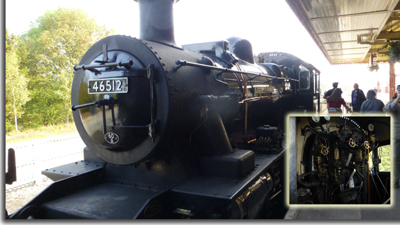 Our next
stop was at Aviemore, where we caught one of the steam locos of the
Strathspey Tourist Railroad pulling into the station.
The operation has four steam locos, as well as diesel power, a
good collection of coaches, and would probably make a good Tracks Ahead
segment. Plus, the people
there knew people involved with the A1 Tornado Project.
Our next
stop was at Aviemore, where we caught one of the steam locos of the
Strathspey Tourist Railroad pulling into the station.
The operation has four steam locos, as well as diesel power, a
good collection of coaches, and would probably make a good Tracks Ahead
segment. Plus, the people
there knew people involved with the A1 Tornado Project.
 We had once more
little stop enroute at an old stone bridge and rapids.
We only lingered a few minutes,
and headed on to Inverness, a city of around 80,000 in the Scottish
Highlands. The countryside
is hilly and loaded with sheep.
There is a great deal of timber production out of this area as
well.
We had once more
little stop enroute at an old stone bridge and rapids.
We only lingered a few minutes,
and headed on to Inverness, a city of around 80,000 in the Scottish
Highlands. The countryside
is hilly and loaded with sheep.
There is a great deal of timber production out of this area as
well.
We had dinner at the
Rocpool Reserve Hotel, a little boutique place up on the hill.
Several of us are getting colds.
While it is a little early to judge, I think I really like
Scotland.
Monday,
September 22
We were off today for the Battlefield of Culloden. Culloden was the last full scale battle to be fought on British soil and the end of the Jacobite uprising. And like most historical battles, the background is, well, "complicated."
The battle occurred on 16 April 1746, between the Jacobite forces of Charles Edward Stuart (Bonnie Prince Charlie) and British loyalist troops commended by William Augustus, Duke of Cumberland. The result of the British victory was to halt for once and for all the Jacobite intent to overthrow the House of Hanover and replace it with the House of Stuart. The battle outcome had global repercussions, as France (Jacobite backer) could no longer support incursions on British soil.
Basically, it involved an uprising by factions (some Scots included) who were attempting to put Prince Charles Stuart back on the throne. They were known as Jacobites. Basically, this was a civil war, with the people supporting Prince Charles Stuart (of the Stuart Line from France) for a bid to regain the throne in England. Charles promised a more representative government for Scottish involvement. The British were on the side of absolute monarchy. The Jacobites pushed down south almost as far as London. But the promised help from France never materialized. Their supply lines were stretched, so they decided to retreat north to Scotland. The British pursued them. And at Culloden, the forces met. The Jacobites made some huge mis-steps in attempting to attack the British. They marched all night to try for a surprise attack, but many were lost in the rugged terrain and the dark. Prince Charles was turning out to be a bit of an arrogant jerk, so there was a lot of side switching and reconsideration. The morning after the abortive night attack, the British were ready to go. The Jacobites were tired, hungry and not very well organized. The result was a slaughter of the Jacobite forces. They lost between 1500-2,000 men to around 50 loyalist dead. That lead to the Clearances, the roundup of suspected supporters, and the banning of the kilt, bagpipes, and anything that spoke to Scottish heritage.
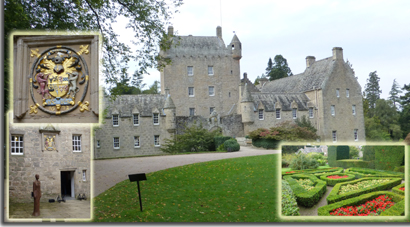 The next
stop was one of our guide George’s top five Scottish castle, the Cawdor
Castle. It was an
interesting castle, still in use today.
The woman who owned the place was the second wife of the Thane of
Cawdor (do I hear Macbeth, anyone?).
She was a model, and about 15-20 years his junior.
They married without the children from his widow knowing about
it. As the children came home to
Christmas at the castle, the presentation was, "here are your presents
and by the way, here’s my new wife."
Things did not go well. The
Thane died. The estate went
to the oldest son, who moved into the castle when wife two was out of
town. But the will had left
her the castle. Enter Scottish
solicitors. The resultant suit left her the castle, and the oldest son the rest of the grounds.
She still lives in it, and has it open for tours in the summer,
as well as parties, catered events, and special functions.
It really was a nice period piece.
There were beautiful gardens, and a maze.
The next
stop was one of our guide George’s top five Scottish castle, the Cawdor
Castle. It was an
interesting castle, still in use today.
The woman who owned the place was the second wife of the Thane of
Cawdor (do I hear Macbeth, anyone?).
She was a model, and about 15-20 years his junior.
They married without the children from his widow knowing about
it. As the children came home to
Christmas at the castle, the presentation was, "here are your presents
and by the way, here’s my new wife."
Things did not go well. The
Thane died. The estate went
to the oldest son, who moved into the castle when wife two was out of
town. But the will had left
her the castle. Enter Scottish
solicitors. The resultant suit left her the castle, and the oldest son the rest of the grounds.
She still lives in it, and has it open for tours in the summer,
as well as parties, catered events, and special functions.
It really was a nice period piece.
There were beautiful gardens, and a maze.
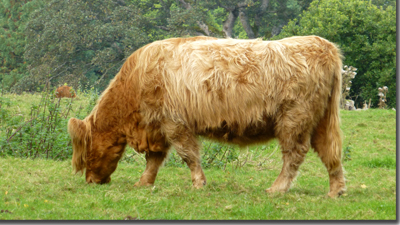
We got at close-up look at the shaggy "heeland coos" - highland cows.
 Lunch was in a nearby little restaurant.
It was charming, with great food, and wonderful ambience.
Lunch was in a nearby little restaurant.
It was charming, with great food, and wonderful ambience.
We finally stumbled into the hotel, and headed out for pizza at a
local place, Zizzi’s, in the
city center. Yum
Tuesday,
September 23
 We checked
out of our digs at the Rocpool Reserve this morning.
It is unfortunate that once you get the faucets and light
switches figured out, it’s time to leave.
The hotel was originally a private residence, but was converted
to a B&B in the mid 90’s and then to a hotel in the early 2000s.
We checked
out of our digs at the Rocpool Reserve this morning.
It is unfortunate that once you get the faucets and light
switches figured out, it’s time to leave.
The hotel was originally a private residence, but was converted
to a B&B in the mid 90’s and then to a hotel in the early 2000s.
Our driver, George Brand was right on time, schlepping the bags, and guiding us on to our next adventure.
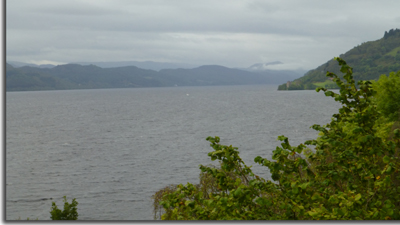 The sky was blue and the landscape bucolic as we made our way
down the west side of Loch Ness.
I’ll tell you right now that Nessie did NOT make an appearance.
The sky was blue and the landscape bucolic as we made our way
down the west side of Loch Ness.
I’ll tell you right now that Nessie did NOT make an appearance.
A brief look at the Loch is here.
 We did a couple of photo stops along the way to our first stop,
which was Urquhart Castle.
Founded around 650, the place was in the hands first of the Donald Clan,
and then in the hands of the Grant clan, up until it’s demolition in the
1100s?. It was typically
Scottish, with the stone walls, and fortifications.
The visitor’s center gave a nice presentation on the place.
We did a couple of photo stops along the way to our first stop,
which was Urquhart Castle.
Founded around 650, the place was in the hands first of the Donald Clan,
and then in the hands of the Grant clan, up until it’s demolition in the
1100s?. It was typically
Scottish, with the stone walls, and fortifications.
The visitor’s center gave a nice presentation on the place.
As we continued, we saw more highland cows, as well as plenty of sheep. The sheep herds usually have 2-3 black sheep mixed in. This is because marauding foxes think that the black ones are sheep dogs, and won’t attack the flock.
 After
seeing the cows we had a photo opportunity in the town of Invers
Morison.
The spot was on a bridge traversing the Moriston River.
Waterfalls and rapids made for a soothing stop.
The old stone bridge was quite picturesque.
After
seeing the cows we had a photo opportunity in the town of Invers
Morison.
The spot was on a bridge traversing the Moriston River.
Waterfalls and rapids made for a soothing stop.
The old stone bridge was quite picturesque.
A video clip is here.
 Afternoon tea was next.
This occurred at the Glengarry Castle Hotel just outside of
Invergarry. The place was
originally a landowners estate, but had been converted into a hotel.
It was lovely. The
rooms were spacious, the views out onto the Loch were simply
breathtaking. The pastries
were also yummy. We lingered
a bit, and Paul made new best buddies with a retired policeman and his
wife, who were staying there.
Honestly, the place was simply so relaxing.
I have a brochure for a potential return.
Afternoon tea was next.
This occurred at the Glengarry Castle Hotel just outside of
Invergarry. The place was
originally a landowners estate, but had been converted into a hotel.
It was lovely. The
rooms were spacious, the views out onto the Loch were simply
breathtaking. The pastries
were also yummy. We lingered
a bit, and Paul made new best buddies with a retired policeman and his
wife, who were staying there.
Honestly, the place was simply so relaxing.
I have a brochure for a potential return.
 Next up were more cows, and a brief stop at the most photographed
castle in Scotland, the Eilean Dolan Castle.
The curving road and stone bridges made for a great “Scottish”
feeling.
Next up were more cows, and a brief stop at the most photographed
castle in Scotland, the Eilean Dolan Castle.
The curving road and stone bridges made for a great “Scottish”
feeling.
By this time it had
started to rain, and we made our way over the Isle of Skye to the Cullin
Hills Hotel. Dinner at the
hotel was great, and your choice of single malts was provided by over 80
types of scotch whisky.
Wednesday,
September 24
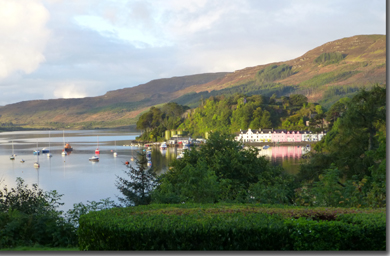 It really
rained last night. And our
beds were hard. But this
morning, the clouds parted, and we were greeted with a sunny, partly
cloudy day. Which was great,
because the clouds gave some patches of contrast to the stunning
landscapes.
It really
rained last night. And our
beds were hard. But this
morning, the clouds parted, and we were greeted with a sunny, partly
cloudy day. Which was great,
because the clouds gave some patches of contrast to the stunning
landscapes.
Our initial view was of the Black Cullins (mountains) and Portree Harbor from the front of our hotel.

Then it was on the road to the Old Man of Stoor, a rock formation.

The trip today was mostly a scenic drive around a portion of the island. And the vistas did not disappoint anyone. One turn of the road brought a vista more spectacular than the last. So there was a lot of sunlight off the water, cloud formations, and green hills with white houses. For some video, click here.
 We did stop at a
living history museum to see how the people on the island lived in the
late 1800’s. Life was pretty
tough. Of interest were the
thatched roofs with the stones used to weight them down against the
strong winds. It can get
quite windy here, as one can see from the lack of brush and ground
scrub. Things just get blown
away. Interestingly though,
due to the Gulf Stream, this area can be warmer than the mainland.
We did stop at a
living history museum to see how the people on the island lived in the
late 1800’s. Life was pretty
tough. Of interest were the
thatched roofs with the stones used to weight them down against the
strong winds. It can get
quite windy here, as one can see from the lack of brush and ground
scrub. Things just get blown
away. Interestingly though,
due to the Gulf Stream, this area can be warmer than the mainland.
 Lunch was in Steen, a little town of probably less than 100
people. But they had 125
malt whisky’s to test, as well as a great little restaurant.
There was a private castle at Dunvegan, but George said that it
really wasn’t worth more than a drive-by photo run.
Lunch was in Steen, a little town of probably less than 100
people. But they had 125
malt whisky’s to test, as well as a great little restaurant.
There was a private castle at Dunvegan, but George said that it
really wasn’t worth more than a drive-by photo run.
 Mostly the
day was craggy vistas, towering hills, some late blooming
heather, and the shimmering sea.
Mostly the
day was craggy vistas, towering hills, some late blooming
heather, and the shimmering sea.
So this is our last night here on the Isle of Skye.
I would highly recommend a trip here.
The summers though, can be extremely crowded.
And then there are the irritating midges.
So plan accordingly.
However, it is gorgeous.
Thursday,
September 25
 We were up early,
to meet the grey and misty morn. We
drove to Drove to
Armadale. A ferry
took us across to Mallaig, former herring capitol of the world.
Unfortunately, the herring industry dried up a few years back due to
over fishing. So the place is upon hard times.
We were up early,
to meet the grey and misty morn. We
drove to Drove to
Armadale. A ferry
took us across to Mallaig, former herring capitol of the world.
Unfortunately, the herring industry dried up a few years back due to
over fishing. So the place is upon hard times.
 Mallaig
is the northern terminus for the West Highland Line on ScotRail.
Mallaig
is the northern terminus for the West Highland Line on ScotRail.
 This is the route of the Hogwarts Express, and is listed as one of the
ten most scenic lines in the world. The train consisted of
four MU cars.
This is the route of the Hogwarts Express, and is listed as one of the
ten most scenic lines in the world. The train consisted of
four MU cars.
The ride would have been unbelievable had the sun been out. But the fog and mist dampened things a bit. However, we still experienced beautiful scenery, which was extremely difficult to capture from a moving train. So you'll have to take my word for it. There were tunnels, rock cuts, grey clouds and mist. We did see the Jacobite Express (Hogwarts Express) of Harry Potter.
 One high point of the ride is the
Glennfinnan viaduct, built with poured concrete.
No, I did not have a drone or a helicopter, but rather went the simple
route with a scanned postcard. The North Highland line is an engineering marvel.
So from the craggy forests of the north, down through the desolation of
Raonac Moor, we worked our way south to Glasgow. We passed
Loch Lomond (we did all sing), and went over the River Clyde into
Central Station in
One high point of the ride is the
Glennfinnan viaduct, built with poured concrete.
No, I did not have a drone or a helicopter, but rather went the simple
route with a scanned postcard. The North Highland line is an engineering marvel.
So from the craggy forests of the north, down through the desolation of
Raonac Moor, we worked our way south to Glasgow. We passed
Loch Lomond (we did all sing), and went over the River Clyde into
Central Station in
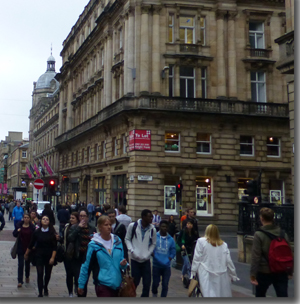 Glasgow.
A video clip here
here.
Glasgow.
A video clip here
here.
Our hotel was within walking distance, and was a tiny boutique hotel on the sixth floor of a commercial building. It was quite nice, but it was small. The bathroom was similar in size to a train bathroom.
Paul, Naomi, Barb and I hopped the local train out to Uplawmoor, where we spent a delightful evening with Owen and Annita, our friends from the Antarctic cruise. We caught practically the last train back into Glasgow, and made our way past some of the local hookers to the hotel.
We are all tired, and I think ready to go home
Friday,
September 26
It was a surprisingly comfortable night in our little hotel room. We got up late, and started the day with the usual hop on, hop off bus tour.
 Our first stop was Cathedral Square.
The main attraction here is Glasgow Cathedral, which is also called the
High Kirk of Glasgow of St. Mungo's Cathedral. The title of
cathedral is historic, dating back to the period before the Scottish
Reformation and its former status as the Roman Catholic mother church of
the Archdiocese of Glasgow.
Our first stop was Cathedral Square.
The main attraction here is Glasgow Cathedral, which is also called the
High Kirk of Glasgow of St. Mungo's Cathedral. The title of
cathedral is historic, dating back to the period before the Scottish
Reformation and its former status as the Roman Catholic mother church of
the Archdiocese of Glasgow.
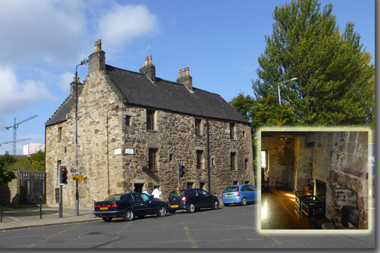
The last remaining cathedral manse house was also found here. All but this one have been torn down, but thankfully, preservationists got to save this one. It was here that we were treated to "Jackie," an older gent who just handed out little tracts of advice to passers-by. And this is what we could all do in retirement!
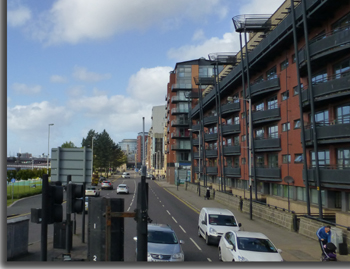 From
Cathedral Square, it was back on the bus for the East End, where the old industries were,
and which are now hip and trendy lofts and the like.
From
Cathedral Square, it was back on the bus for the East End, where the old industries were,
and which are now hip and trendy lofts and the like.
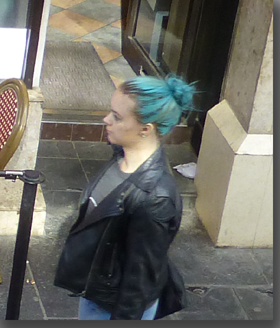 Glasgow
had a lot mof people around the town, which I guess would be expected
for a large city. Of note were the number of women sporting hair
colors not really found in nature.
Glasgow
had a lot mof people around the town, which I guess would be expected
for a large city. Of note were the number of women sporting hair
colors not really found in nature.
 We started on the West end, with the Universities, but stopped at
the Transportation Museum where Barb, Paul and I bailed off the bus.
This was a great museum, with cars, trains, trolleys, and ships.
The latter were reminiscent of the Clyde shipbuilding days.
We started on the West end, with the Universities, but stopped at
the Transportation Museum where Barb, Paul and I bailed off the bus.
This was a great museum, with cars, trains, trolleys, and ships.
The latter were reminiscent of the Clyde shipbuilding days.
There was a "Wall of Cars" featuring many of the old automobiles from the turn of the 1900s, as well as a steam powered truck, that was able to haul six times it's own weight, and ran faithfully for some 60 years. Of interest to me - naturally - was the model train shop, which had a great deal of older British model railroad paraphernalia.
 Finally,
exhausted from looking at trains, buses, cars, and other forms of
transportation, we hopped back on the bus to finish the day.
Finally,
exhausted from looking at trains, buses, cars, and other forms of
transportation, we hopped back on the bus to finish the day.
The Duke of Wellington stature is quite famous due to the hat he always seems to wear. The city maintenance workers always remove the traffic cone, but somehow, another always appears overnight.
We wandered around a little bit close to hotel, and then headed out for Italian for dinner.

So it is time to go home. Glasgow as a lovely city, and had many sights to offer and to explore. Unfortunately, or limited time only allowed us to brush the surface. A return trip would be in order.
So we are repacked and we have our "going home" clothes out and ready for our early call tomorrow. We’ll chase the sun all day. It will be long flight, but hopefully it should be broken up by the layover in Newark.
This was
a great trip. We met so many nice people, from our guides, to the
people we would talk to along the way.
Between the two countries, I liked both, but felt more at home in
Scotland.